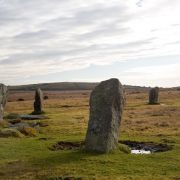Boscawen Un Stone Circle
As with other megalithic sites, significance is attributed to the stones and their position, and the number 19 is a common number among stone circles, often being associated with the cycle of the moon. Furthermore, the central stone (although actually positioned just southwest of the true centre) is believed to predate the circle and have been used for ritualistic purposes in the Neolithic age, parallels being drawn between it and menhirs in Brittany. One of the similarities lies in the two feint axe-shaped engravings at its base – a practice unseen on megaliths of this age in the UK. The stone measures close to three metres in length but, because it lies at an angle, its highest point is only around 2m high. Although it is unsure whether the tilt is intentional or the result of interim treasure hunting, it has been suggested that its angle and shape depict a cutting axe and that it was originally integral to Neolithic ritual, perhaps fertility ceremonies.
- There is a gap which breaks the circle at the west, similar to that of the nearby Merry Maidens stone circle. The evenly spaced granite stones that form the slightly oval ring measure between 1 and 1.5m in height and are fairly regularly shaped, one being unusual in that it is contains a large amount of white quartz stone. Some believe that this white stone in the southwest of the circle is the female balance to the very male and phallic central pillar. Its position is also that of the setting midsummer moon, lending more credence to its feminine symbolism.
In terms of connections with other megalithic sites, a set of stones in the northeast of the circle seem to be more aligned than the centre or the pillar and lie in the direction of the rising midsummer sun, suggesting that they have more significance than is perhaps obviously attributed to them.
When constructed, this stone circle would have been used for all manner of ritual and community ceremony, from religious to political. Much later, in the Middle Ages, the circle was used for Druidic gatherings and, indeed, the Cornish Gorsedd inaugurated its annual meeting of bards at Boscawen-Un in 1928.







